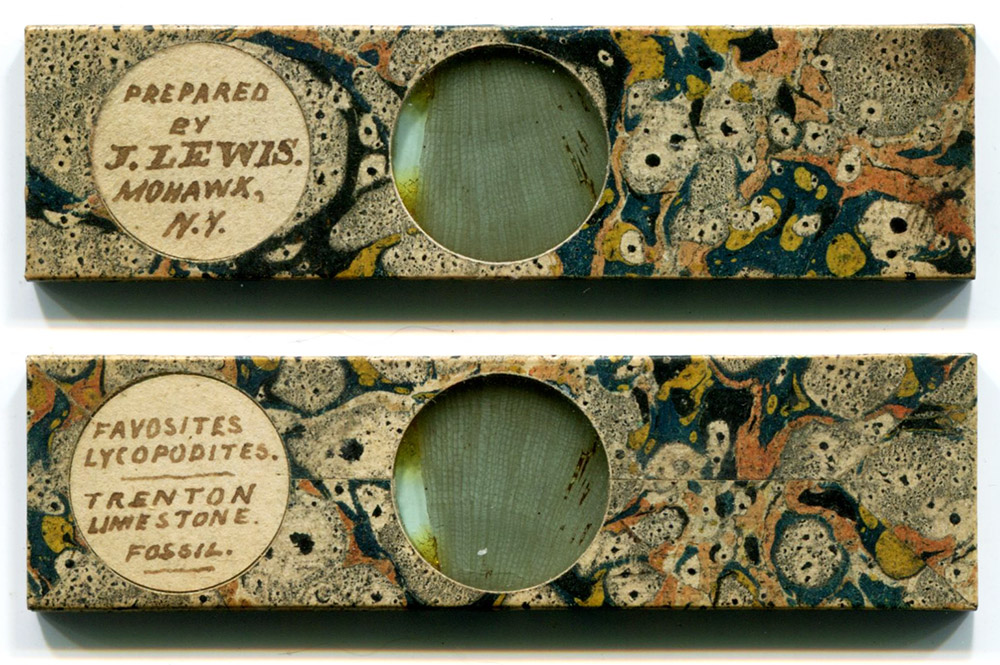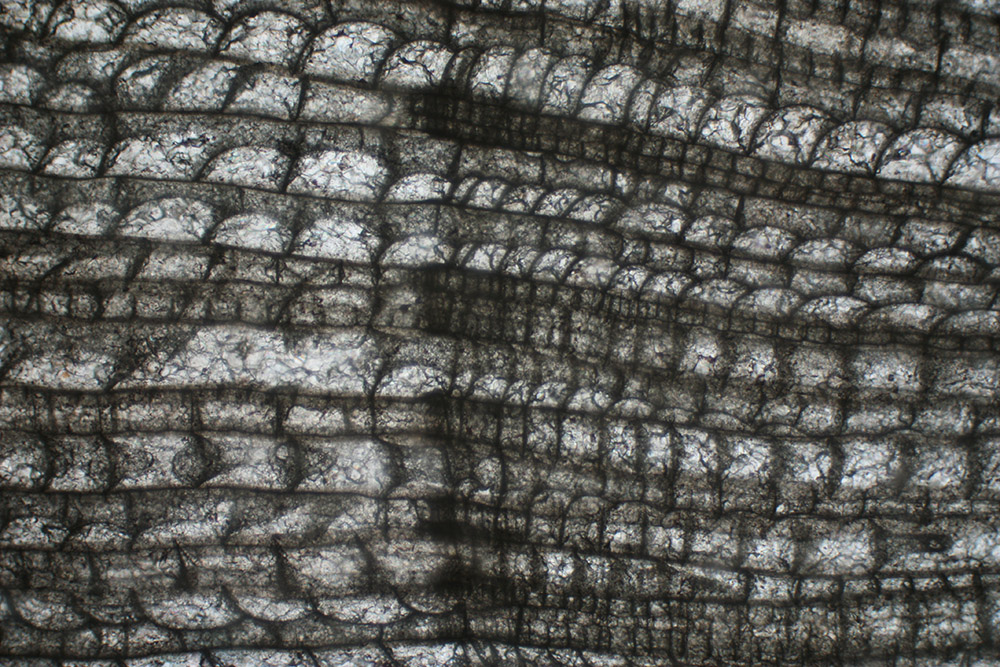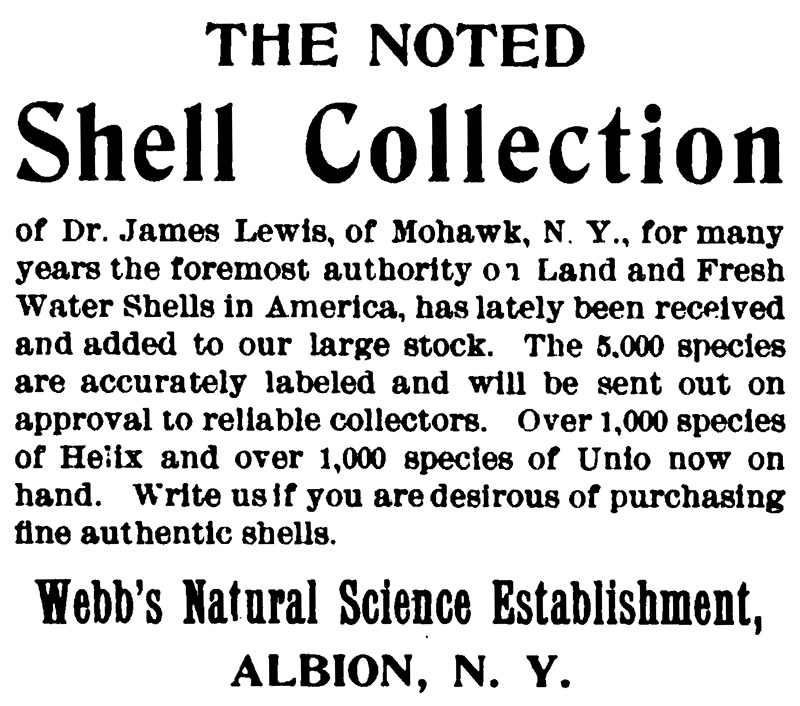James Lewis, 1822 - 1881
by Brian Stevenson
last updated September, 2021
Microscope slides by James Lewis, of Mohawk, New York, are relatively rare. His known mounts are well prepared, with specimens and finish of high quality. Lewis was a trained physician who specialized in dentistry. It is possible that his medical specialty helped him learn the lapidary techniques necessary to prepare the thin-sectioned fossil shown in Figures 1 and 2.
His primary scientific field was conchology, that is, the study of snails, bivalves, and other mollusks. He published extensively in that field, and left behind an extensive collection of American snail and freshwater bivalve shells.

Figure 1.
Front and back of a ca. 1860 microscope slide that was prepared by James Lewis. It is roughly "continental" in size (2 1/4 x 5/8 inches, 58 x 16 mm), made from two glass slips of equal thickness. The fossil specimen is mounted in balsam, which also seals the glasses together. The mount is completely wrapped in a colorful marbled paper. The descriptive labels are mounted underneath the wrapping paper, exposed by cut-out circles in the wrapper.

Figure 2.
Magnified image of a finely-ground transverse section of fossil Favosites lycopodites (an extinct coral), collected from the Trenton limestone formation. Prepared by James Lewis (Figure 1). Photographed with a 3.5x objective lens, transmitted light, and a C-mounted digital SLR camera.
A conchology colleague, Richard Ellsworth Call (1856-1917) wrote the following memoriam for James Lewis, which was published in The American Naturalist, 1881:
"Dr. James Lewis, the well-known conchologist, died of apoplexy, at his home at Mohawk, N. Y., February 23, 1881. He was born at Schuyler's lake, Otsego Co., New York, in July, 1822. He was, therefore, nearly 59 years of age at the time of his death.
Like many another who has become distinguished in natural science, his earlier education was confined chiefly to the common school. At the age of twenty-four he began to read medicine, and prosecuted his studies for some three years, when he became interested in dentistry, and abandoning the broad field of general medicine, devoted himself to this special branch of medical science. For this he was eminently fitted by his great mechanical skill, and to the implements employed in his art he contributed many permanently valuable improvements.
It is as a naturalist that we have to consider Dr. Lewis. He became interested in nature in his childhood, and that interest deepened with years into admiration, and admiration into love, which led him to intelligent, untiring pursuit. It was while he resided in Boston, Massachusetts, from 1849 to 1851 that he became interested in his favorite science and formed the nucleus of what was to become one of the most valuable private collections of American land and fresh-water shells extant. From that time until a year or two previous to his death, he was a most devoted student and untiring enthusiastic collector.
He is widely known to the authorities in the science he cultivated by a very extensive correspondence, of which art Dr. Lewis was certainly a master. Within the scope of his acquaintance are embraced all the living names familiar to the younger naturalists, and many others who have passed away.
His published works, when the magnitude of his labors and the opportunities they have presented are considered, have not been many, but all published possess permanent value. They date from 1854, and number some eleven titles. The first consists of notes on 'Alas. (Marg) marginata', published in 1854, In 1856 he published three papers, two in the Proc. Bos. Soc. Nat. Hist, and one in the Proc. Acad. Nat. Sci., all relating to the Mollusca of the State of New York, and two of them are local lists, with notes. In 1857 he published a single paper 'On Erosion of Uniones', in Proc. Bos. Soc. Nat. Hist. In 1860, two papers, one on 'Colors of Unionidae', and the other a local list, both of which appeared in the Proc. Acad. Nat. Sciences of Philadelphia. He published nothing further until 1868, when appeared a paper in the Am. Four. of Conchology, 'On the Mollusks of the Mohawk valley'. In 1869, in the same journal, he published a valuable paper 'On the Shells of the Coosa river', Alabama. The bibliography and indices of Dr. Lea's 'Synopsis of the Unionidae' next engaged his attention, and they are, in great part, largely arranged by him. His last published work of value appears in the Geological Report of Alabama for 1875(?), and contains the almost complete geographical distribution, by streams, of the shells of that State. Some very suggestive remarks are likewise appended as notes to the work which he has there performed. He was also an occasional contributor to the Naturalist. The major part of his life's work remains behind him in the form of MSS., many of which had they been published, would add largely to our knowledge of fresh-water forms. The most of these have passed into the hands of my collaborateur, Mr. A.F. Gray.
The great work of Dr. Lewis was as a systematist. In this field he was an acknowledged master, and here his services were frequently required by individuals and freely given. He arranged and classified many public collections, among which were the American fresh-water shells in the Smithsonian Institution, the last critical revision of which was made by him; the collection of the Buffalo Academy of Natural Science, those of Vassar College, Mount Holyoke Seminary, Wellesley, and Hamilton Colleges, and the State Cabinet at Albany. The examination of these extensive collections furnished him with material for the determination of synonomy, which, had he lived to complete it, would have very greatly reduced the number of acknowledged species. In work of this character he was truly philosophic, and his opinions commanded and obtained respect. The great changes in scientific thought occasioned by the doctrines of evolution, found an ardent advocate in him, and those great principles formed the basis of all his later work. He has often remarked, and repeated it to others in his correspondence, that the great work of the future would be done from this standpoint, and much remains to be done in eradicating the errors of the older naturalists.
He was a conscientious worker, an acute thinker, and a man of great research. In the prosecution of his studies he was indefatigable, and here was the cause of his disease - a nervous disorder which reached its climax in his death. He lived but five hours after the apoplectic stroke, and died without regaining consciousness.
His merits were recognized by various scientific societies in electing him to a membership, among which were the Philadelphia Academy, the Boston Society Nat. Hist., the American Association for the Advancement of Science and the Buffalo Academy. To the publications of all these he was a contributor.
In his death science loses a man of no ostentation, but of patient and painstaking endeavor; in manner he was reserved at times, but always gentlemanly and courteous; he was single in his purpose, and devoted in pursuit of his objects. It is with a deep sense of personal loss that these lines are penned in memory of one who was universally kind and helpful; a kindness and helpfulness that many another has shared time and again at the hands of Dr. Lewis; advice was always freely given, nor was aid ever denied when aid was needed. His death is a loss to American science that all will deplore."

Figure 3.
An 1899 advertisement for the sale of James Lewis' shell collection, from "Popular Science News".
Resources
Call, R.E. (1881) Memoriam of Dr. James Lewis, The American Naturalist, pages 506-508
Popular Science News (1899) Advertisements for the sale of James Lewis' shell collection, Vol. 33, advertising section, numerous issues


